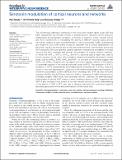| dc.contributor.author | Celada, Pau | |
| dc.contributor.author | Artigas, Francesc | |
| dc.contributor.author | Puig Velasco, Maria Victoria | |
| dc.date.accessioned | 2013-09-03T15:10:15Z | |
| dc.date.available | 2013-09-03T15:10:15Z | |
| dc.date.issued | 2013-04 | |
| dc.date.submitted | 2013-01 | |
| dc.identifier.issn | 1662-5145 | |
| dc.identifier.uri | http://hdl.handle.net/1721.1/80338 | |
| dc.description.abstract | The serotonergic pathways originating in the dorsal and median raphe nuclei (DR and MnR, respectively) are critically involved in cortical function. Serotonin (5-HT), acting on postsynaptic and presynaptic receptors, is involved in cognition, mood, impulse control and motor functions by (1) modulating the activity of different neuronal types, and (2) varying the release of other neurotransmitters, such as glutamate, GABA, acetylcholine and dopamine. Also, 5-HT seems to play an important role in cortical development. Of all cortical regions, the frontal lobe is the area most enriched in serotonergic axons and 5-HT receptors. 5-HT and selective receptor agonists modulate the excitability of cortical neurons and their discharge rate through the activation of several receptor subtypes, of which the 5-HT[subscript 1A], 5-HT[subscript 1B], 5-HT[subscript 2A], and 5-HT[subscript 3] subtypes play a major role. Little is known, however, on the role of other excitatory receptors moderately expressed in cortical areas, such as 5-HT[subscript 2C], 5-HT[subscript 4], 5-HT[subscript 6], and 5-HT[subscript 7]. In vitro and in vivo studies suggest that 5-HT[subscript 1A] and 5-HT[subscript 2A] receptors are key players and exert opposite effects on the activity of pyramidal neurons in the medial prefrontal cortex (mPFC). The activation of 5-HT[subscript 1A] receptors in mPFC hyperpolarizes pyramidal neurons whereas that of 5-HT[subscript 2A] receptors results in neuronal depolarization, reduction of the afterhyperpolarization and increase of excitatory postsynaptic currents (EPSCs) and of discharge rate. 5-HT can also stimulate excitatory (5-HT[subscript 2A] and 5-HT[subscript 3]) and inhibitory (5-HT[subscript 1A]) receptors in GABA interneurons to modulate synaptic GABA inputs onto pyramidal neurons. Likewise, the pharmacological manipulation of various 5-HT receptors alters oscillatory activity in PFC, suggesting that 5-HT is also involved in the control of cortical network activity. A better understanding of the actions of 5-HT in PFC may help to develop treatments for mood and cognitive disorders associated with an abnormal function of the frontal lobe. | en_US |
| dc.language.iso | en_US | |
| dc.publisher | Frontiers Research Foundation | en_US |
| dc.relation.isversionof | http://dx.doi.org/10.3389/fnint.2013.00025 | en_US |
| dc.rights | Article is made available in accordance with the publisher's policy and may be subject to US copyright law. Please refer to the publisher's site for terms of use. | en_US |
| dc.source | Frontiers Research Foundation | en_US |
| dc.title | Serotonin modulation of cortical neurons and networks | en_US |
| dc.type | Article | en_US |
| dc.identifier.citation | Celada, Pau, M. Victoria Puig, and Francesc Artigas. “Serotonin modulation of cortical neurons and networks.” Frontiers in Integrative Neuroscience 7 (2013). | en_US |
| dc.contributor.department | Picower Institute for Learning and Memory | en_US |
| dc.contributor.mitauthor | Puig Velasco, Maria Victoria | en_US |
| dc.relation.journal | Frontiers in Integrative Neuroscience | en_US |
| dc.eprint.version | Final published version | en_US |
| dc.type.uri | http://purl.org/eprint/type/JournalArticle | en_US |
| eprint.status | http://purl.org/eprint/status/PeerReviewed | en_US |
| dspace.orderedauthors | Celada, Pau; Puig, M. Victoria; Artigas, Francesc | en_US |
| mit.license | PUBLISHER_CC | en_US |
| mit.metadata.status | Complete | |
